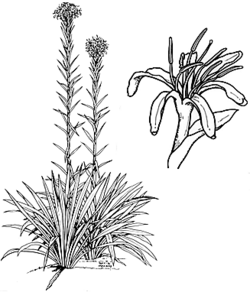
Description: Giant rosette plants with a short basal stem; roots thick, rather fleshy. aving a broad ragged apex.
Basal leaves spiral, thickened, dorsiventral, with a terete then convulute brown tip, withering and leaving a broad ragged apex.
Inflorescence a compound raceme, elongate or globose, on long, erect scape with numerous short, thinner textured, sheathing leaves. Flowers actinomorphic or slightly zygomorphic, 3-merous, bisexual, each subtended by a large bract. Tepals 6, in 2 whorls, united shortly at base, spathulate and slightly expanded. Stamens 6; filaments linear-subulate, somewhat enlarged at base, fused to tepals for about half the length, then erect; anthers pseudo-basifixed (peltate but with the apex of the filament enclosed in a tube formed by the connective), dehiscing by longitudinal slits. Ovary inferior, 3-locular, with numerous ovules; style 1, with 3 furrows; stigma 3-angled. Septal nectaries present at base of tepals at top of ovary.
Fruit a loculicidal capsule; seeds many per loculus, brown, kidney-shaped, compressed, with a papery wing.
Distribution and occurrence: World: 2 species, endemic Australia. Australia: Qld & N.S.W.
Both species are cultivated as ornamentals; interest was expressed at one time in using the leaf fibres commercially.
Text by K. L. Wilson
Taxon concept:
| | Key to the species | |
| 1 | Inflorescence globose, to 70 cm diam.; leaves to c. 2.5 m long; anthers 27–38 mm long | Doryanthes excelsa |
| Inflorescence elongated, toothbrush-like, to 120 cm long; leaves to 3 m long; anthers 12–18 mm long | Doryanthes palmeri |
|


